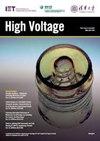Nondestructive Measurement of Residual Stress on Epoxy Insulators Using Thermoelastic Method
IF 4.9
2区 工程技术
Q1 ENGINEERING, ELECTRICAL & ELECTRONIC
引用次数: 0
Abstract
Residual stress is inevitable in epoxy insulators, which easily leads to small cracks and even insulation breakdown during the operation of gas-insulated transmission line (GIL)/gas-insulated switchgear (GIS). This study proposes a nondestructive method to measure the residual stress on epoxy insulators using thermoelastic effects. First, the laser-induced temperature rise of the epoxy/Al2O3 composite was measured under different mechanical stresses to establish a relationship between the relative temperature rise and mechanical stress. Then, the residual stress distributions on full-sized insulators were reconstructed based on the stress–temperature relationship by scanning and measuring the relative temperature rise values at distributed points. The results show that the temperature rise of the epoxy/Al2O3 composite is promoted by tensile stress but inhibited by compressive stress, reflecting the impacts of mechanical stress on the thermal properties of epoxy insulators. Compressive stress is present on the outer side, whereas tensile stress is concentrated on the inner side of both basin-type and tri-post insulators, with maximum values around 30 MPa. During curing, a higher temperature on the outer side of the mould leads to a faster curing rate of the insulator than on the inner side. This, combined with the mismatch of thermal expansion coefficients between epoxy and aluminium, contributes to the generation of residual stress. The measurement results of residual stress are consistent with the theoretical analysis results, verifying the effectiveness of the proposed method and offering new insights into the measurement of residual stress.热弹性法无损测量环氧绝缘子残余应力
环氧树脂绝缘子不可避免地存在残余应力,在气体绝缘输电线路/气体绝缘开关柜运行过程中容易产生细小裂纹甚至绝缘击穿。本文提出了一种利用热弹性效应无损测量环氧绝缘子残余应力的方法。首先,测量了不同机械应力下环氧树脂/Al2O3复合材料的激光诱导温升,建立了相对温升与机械应力的关系。然后,通过扫描和测量分布点的相对温升值,基于应力-温度关系重构了全尺寸绝缘子的残余应力分布;结果表明:拉伸应力促进了环氧树脂/Al2O3复合材料的升温,压应力抑制了其升温,反映了机械应力对环氧树脂绝缘子热性能的影响;盆式和三柱式绝缘子的压应力主要集中在外侧,拉应力主要集中在内侧,最大值在30 MPa左右。在固化过程中,模具外侧的温度越高,绝缘子的固化速度就越快。这与环氧树脂和铝之间热膨胀系数的不匹配相结合,有助于产生残余应力。残余应力的测量结果与理论分析结果一致,验证了所提方法的有效性,为残余应力的测量提供了新的思路。
本文章由计算机程序翻译,如有差异,请以英文原文为准。
求助全文
约1分钟内获得全文
求助全文
来源期刊

High Voltage
Energy-Energy Engineering and Power Technology
CiteScore
9.60
自引率
27.30%
发文量
97
审稿时长
21 weeks
期刊介绍:
High Voltage aims to attract original research papers and review articles. The scope covers high-voltage power engineering and high voltage applications, including experimental, computational (including simulation and modelling) and theoretical studies, which include:
Electrical Insulation
● Outdoor, indoor, solid, liquid and gas insulation
● Transient voltages and overvoltage protection
● Nano-dielectrics and new insulation materials
● Condition monitoring and maintenance
Discharge and plasmas, pulsed power
● Electrical discharge, plasma generation and applications
● Interactions of plasma with surfaces
● Pulsed power science and technology
High-field effects
● Computation, measurements of Intensive Electromagnetic Field
● Electromagnetic compatibility
● Biomedical effects
● Environmental effects and protection
High Voltage Engineering
● Design problems, testing and measuring techniques
● Equipment development and asset management
● Smart Grid, live line working
● AC/DC power electronics
● UHV power transmission
Special Issues. Call for papers:
Interface Charging Phenomena for Dielectric Materials - https://digital-library.theiet.org/files/HVE_CFP_ICP.pdf
Emerging Materials For High Voltage Applications - https://digital-library.theiet.org/files/HVE_CFP_EMHVA.pdf
 求助内容:
求助内容: 应助结果提醒方式:
应助结果提醒方式:


